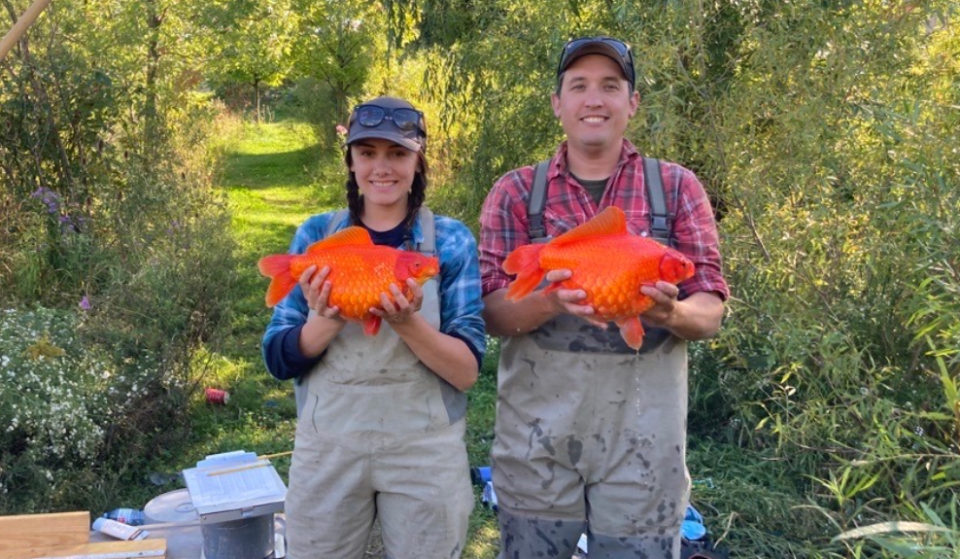Football-sized goldfish cloning themselves in B.C., Ontario waters

For years officials have asked the public to refrain from releasing goldfish into public waterways.
The fish are hardy and reproduce quickly - releasing up to 50,000 eggs at a time, three times a summer - and can threaten native species.
That's the case in parts of British Columbia and Ontario, according to reporting from the Vancouver Sun and the Canadian Press (CP).
Out west, experts are tracking goldfish invasions in lakes near Terrace, Quesnel, and Whistler. Lake Ontario's Hamilton Harbour is another problem area. In 2021, Ontario officials noted the fish were breeding in spawning sites usually occupied by native species like northern pike.
Speaking with CP, Brian Heise, an associate professor in the department of natural resource sciences at Thompson Rivers University, says one reason goldfish multiply fast is because females can clone without the help of a male.

Giant goldfish pulled from Hamilton Harbour in 2021 (Fisheries and Oceans Canada/Facebook)
“Female goldfish have a special process called gynogenesis in which the female will get the sperm from a different kind of minnow … to start the eggs developing, even though they’re not fertilized,” he tells the publication.
“And so she produces clones of herself. So, they’re very good at spreading rapidly.”
Ever wonder what happens to pet goldfish when they end up in our waterways? This one was pulled from Hamilton Harbour, where we're studying this #InvasiveSpecies using acoustic transmitter tags. pic.twitter.com/GFCsBcIadV
Ever wonder what happens to pet goldfish when they end up in our waterways? This one was pulled from Hamilton Harbour, where we’re studying this Fisheries and Oceans on Twitter: "Ever wonder what happens to pet goldfish when they end up in our waterways? This one was pulled from Hamilton Harbour, where we're studying this #InvasiveSpecies using acoustic transmitter tags. pic.twitter.com/GFCsBcIadV / Twitter" using acoustic transmitter tags. Fisheries and Oceans on Twitter: "Ever wonder what happens to pet goldfish when they end up in our waterways? This one was pulled from Hamilton Harbour, where we're studying this #InvasiveSpecies using acoustic transmitter tags. pic.twitter.com/GFCsBcIadV / Twitter"
— Fisheries and Oceans (@FishOceansCAN) Fisheries and Oceans on Twitter: "Ever wonder what happens to pet goldfish when they end up in our waterways? This one was pulled from Hamilton Harbour, where we're studying this #InvasiveSpecies using acoustic transmitter tags. pic.twitter.com/GFCsBcIadV / Twitter"
The fish can easily reach the size of a football or larger.
It's not clear how the fish have ended up in the water, but they've been there for about twenty years.
There is high suspicion it's due to people releasing unwanted pets into local stormwater ponds, which can leak into much larger bodies of water.
"This is a big problem because, in large numbers, goldfish can destroy aquatic habitats by tearing up aquatic plants for food and clouding the waters, which means less sunlight and less food for our native species," Fisheries and Oceans Canada says in a Facebook post.
"They can also thrive on toxic blue-green algae and may even aid in toxic algal growth."
1/3 Think before you flush that unwanted critter down the drain! 🤔🐠DYK that animals and plants intended for aquariums and artificial ponds can be harmful when released into the wild? pic.twitter.com/MIHyoJjZb9
1/3 Think before you flush that unwanted critter down the drain! 🤔🐠
DYK that animals and plants intended for aquariums and artificial ponds can be harmful when released into the wild? Fisheries and Oceans on Twitter: "1/3 Think before you flush that unwanted critter down the drain! 🤔🐠DYK that animals and plants intended for aquariums and artificial ponds can be harmful when released into the wild? pic.twitter.com/MIHyoJjZb9 / Twitter"— Fisheries and Oceans (@FishOceansCAN) Fisheries and Oceans on Twitter: "1/3 Think before you flush that unwanted critter down the drain! 🤔🐠DYK that animals and plants intended for aquariums and artificial ponds can be harmful when released into the wild? pic.twitter.com/MIHyoJjZb9 / Twitter"
"The other thing people probably don't think about is that when we introduce species like this we could be introducing a disease that isn't found in Ontario," Jeff K. Brinsmead, a senior invasive species biologist with the Ontario Ministry of Natural Resources, told The Weather Network in 2021.
"If you have plants in your aquarium and you release the fish, and some plant material goes out, those plants could become invasive potentially."
If you are trying to get rid of a goldfish, consider re-homing it or donating it to a classroom or an office with a waiting room aquarium.
RELATED: Meet the invasive vampire-like fish that lives in the Great Lakes
Thumbnail image: Giant goldfish pulled from Hamilton Harbour in 2021 (Fisheries and Oceans Canada/Facebook)

